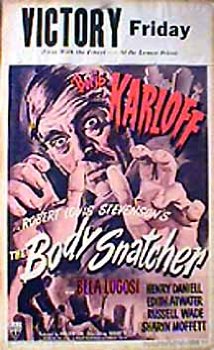One can’t help admiring Val Lewton and his crew at RKO, working on tiny budgets, but producing miniature gems. It’s like painting a masterpiece on the head of a pin. Robert Wise was his director here but the credit goes mainly to producer Lewton, the Russian master of Who Torok. Lewton was insistent on authenticity. The songs we hear are contemporary Scottish folk songs and the wardrobe as close to the real thing as they could get. And Lewton saw to it that “reality” was evoked by small items from the prop department and small incidents on screen. At night, for instance, in order to see something in a dark basement, the doctor calls out for someone to bring a candle. In a less thoughtful movie the deserted basement would have a couple of lanterns already lighted, or the set would be brightly lighted with no visible lanterns at all. A small thing, as I say.
But it’s not just historical accuracy that makes Lewton’s RKO pictures so appealing. His plots are rooted in time. And his scripts are — how can one put this without sounding snotty? — “literate”. (“Oh, how we cozzened them!”) I don’t know how closely the dialogue sticks to Stevenson’s original story but it works very well, partly because the actors are so competent. Stealing the dialogue isn’t necessarily a bad thing when the words are good to begin with. John Huston lifted most of his dialogue for “The Maltese Falcon” directly from Hammett’s novel. And Shakespeare ripped off whole sections of Plutarch’s “Lives” for “Julius Caesar.” Henry Daniell, like Robert Douglas, later became stereotyped as heavies in Errol Flynn swashbucklers, but Danielle has a far more complex role here — proud of his medical skills but driven insane by that pride. The accents are mostly American, alas, but the performers at least LOOK right.
Then there is the plot. I know it sounds odd in a producer of horror movies but Lewton was a man of good taste. Driven to find a dead body to sell to Daniell, Karloff decides to murder a sweet-faced young blind girl who is a street singer. A modern movie would give us a bathtub full of blood. Here’s what Lewton does. The little girl walks alone down a deserted cobblestone street at night, singing a melancholy tune as she goes. The camera is held on her as she walks under a bridge and disappears in the darkness on the other side. Without any cuts, Karloff’s horse and coach enter the frame, plodding slowly along in the girl’s wake. The coach disappears into the same darkness under the bridge. We hear the girl’s carol cut off at the end of a note with a slight squeak. End of shot. It’s a far more moving moment than a dozen multiple on screen slashings and throat cuttings and we haven’t seen any of it.
The ending, however, is fairly explicit. Daniell, now mad, gallops furiously through the rainy night along muddy roads, the recently “resurrected” dead body bouncing along in the seat beside him. Instead of the dead woman he has just disinterred, the body is now that of Karloff, revealed only when lightning blindingly illuminates the crazily rocking coach.
“The Body Snatcher” doesn’t have the easy shocks of some of Lewton’s other works, like “The Curse of the Cat People,” no “buses” as Lewton called them.
But there is a sense of evil throughout, or let’s call it corruption, and it grows as the film moves quietly along. In its own way it’s the equal of anything Lewton did before or after.

